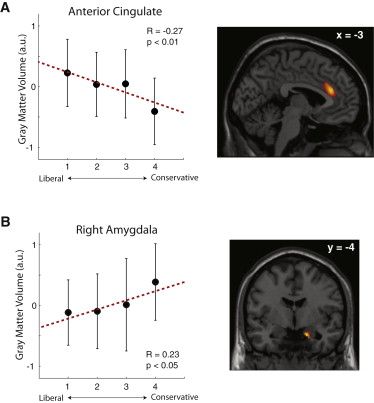"Researchers at University College London recruited ninety students, and had them confidentially place themselves on a five-point political spectrum. ... Their choices could range from 'very conservative' to 'very liberal.' Then neuroscientist Geraint Rees used magnetic resonance imaging (MRls) to scan each of their brains.
"The results were stunning. From the MRls, the scientists were able to accurately predict which of those individuals was more likely to be a liberal or a conservative. The more conservative students had a larger right amygdala; greater liberalism, on the other hand, was associated with a larger anterior cingulate. ... "
And, in general, We ARE either mostly conservative or mostly liberal:
"The National Election Studies, which are the leading survey of voters in US presidential polls, have found that over three quarters of Americans feel comfortable pinpointing their views on a two-dimensional political spectrum. ... Collecting people's liberal-conservative self-placements is useful because they correlate very strongly with their actual voting habits...It doesn't surprise me, now, that we can't talk to one another. We're not even, mostly, wired the same.
"The important point ... is this: ordinary people everywhere use the concepts of 'left' and 'right' to describe their political orientations. So the left-right political spectrum is universal. It forms a natural, bell-shaped curve...."
Delancey Place provides a daily email on a range of topics of interest: science, history, art, culture, and so on. You can sign up here.

Correlation does not equal causation.
ReplyDeleteRead "Moral Politics" by George Lakoff, which delves into the topic much more deeply. We're not as binary as convenience would have us believe.